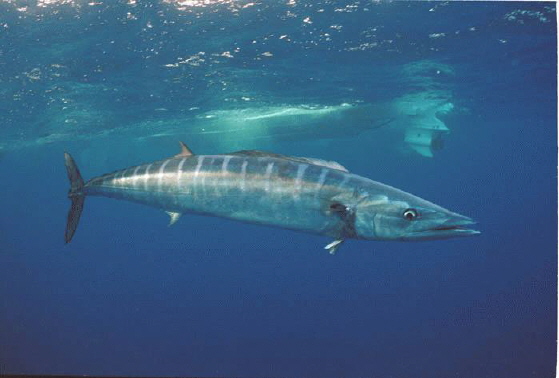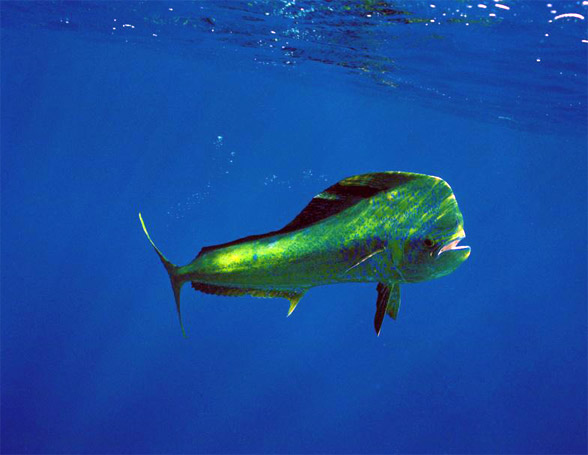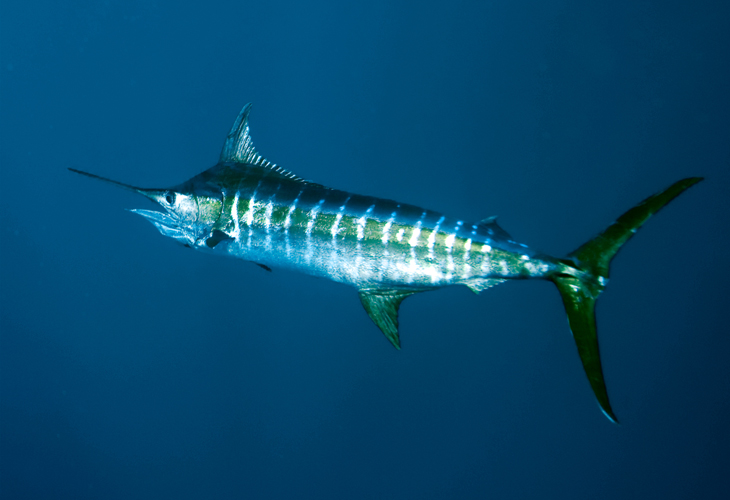The striped marlin is a small species of marlin found in tropical to temperate Indo-Pacific oceans not far from the surface. It is seasonally migratory, moving toward the equator during the cold season and away again during the warm season. It weighs in around 420 lb and a length of 13.8 ft. The striped marlin is a predator that hunts during the day in the top 100 metres or so of the water column, often near the surface. One of their chief prey is sardines.
It has an elongated body, a spear-like snout or bill, and a long, rigid dorsal fin which extends forward to form a crest. This dorsal fin is the most distinguishing characteristic, which normally equals or exceeds the greatest body depth. Even in the largest specimens this fin is at least equal to 90 percent of the body depth. Its common name is thought to derive from its resemblance to a sailor's marlinspike. Marlins are fast swimmers, reaching speeds of about 50 mph.
The Striped Marlin is highly predatory, feeding extensively on pilchards, anchovies, mackerel, sauries, flying fish, squid, and whatever is abundant. It is well known for its fighting ability and has the reputation of spending more time in the air than in the water after it is hooked. In addition to long runs and tail walks, it will “greyhound” across the surface, making up to a dozen or more long, graceful leaps. It can be caught fairly close to shore, and lacking the size and weight of the blue marlin or the black marlin, it is more acrobatically inclined. Fishing methods include trolling whole fish, strip baits, or lures; also live bait fishing
In Hawaii, the wahoo is known as ono. Ono is found worldwide in tropical and subtropical seas. It is best known to sports fishermen for its speed and high-quality flesh make it a prize game fish. 
The flesh of the Ono is white to grey, delicate to dense, and highly regarded by many gourmets. The taste is similar to mackerel, though arguably less pronounced. In many areas of its range, such as Hawaii, local demand for Ono is met by artisanal commercial fishermen, who take them primarily by trolling, as well as by recreational sports fishermen who sell their catch.
Ono's body is elongated and covered with small, scarcely visible scales; the back is an iridescent blue, while the sides are silvery, with a pattern of irregular vertical blue bars and have razor sharp teeth. These colors fade rapidly at death. The mouth is large, and both the upper and lower jaws have a somewhat sharp appearance.
Specimens have been recorded at up to 8 ft in length, and weighing up to 183 lb, growth is known to be rapid. Ono can swim up to 60 mph. They are some of the fastest fish in the sea!
Ono tend to be solitary or occur in loose-knit groups of two or three fish, but where conditions are suitable can be found in schools as large as 100 or more. Their diet is made up of other fish and squid.
Catch Ono today! Book now
Mahi-mahi means "very strong" in Hawaiian (also known widely as dorado) is a surface-dwelling ray-finned fish found in off-shore temperate, tropical and subtropical waters worldwide. 
Mahi-mahi can live up to 5 years, although they seldom exceed four. Catches average 15 to 29 lb. They seldom exceed 33 lb, and mahi-mahi over 40 lb are exceptional.
Mahi-mahi have compressed bodies and a single long-based dorsal fin extending from the head almost to the tail. Their caudal fins and anal fins are sharply concave. They are distinguished by dazzling colors: golden on the sides, and bright blues and greens on the sides and back. Mature males have prominent foreheads protruding well above the body proper. Females have a rounded head. Females are also usually smaller than males.
The pectoral fins of the mahi-mahi are iridescent blue. The flank is broad and golden. 3 black diagonal stripes appear on each side of the fish as it swiftly darts after prey.
Out of the water, the fish often change color, going though several hues before finally fading to a muted yellow-grey upon death.
Mahi-mahi are among the fastest-growing fish. They spawn in warm ocean currents throughout much of the year, and their young are commonly found in seaweed. Mahi-mahi are carnivorous, feeding on flying fish, crabs, squid, mackerel, and other forage fish. They have also been known to eat zooplankton and crustaceans.
Mahi-mahi often swim near debris such as floating wood, palm trees and fronds, or sargasso weed lines and around fish buoys.
Mahi-mahi are highly sought for sport fishing and commercial purposes. Sport fishermen seek them due to their beauty, size, food quality, and healthy population. 
Thirty- to fifty-pound gear is more than adequate when trolling for mahi-mahi. Fly-casters may especially seek frigatebirds to find big mahi-mahis, and then use a bait-and-switch technique. Ballyhoo or a net full of live sardines tossed into the water can excite the mahi-mahis into a feeding frenzy. Hookless teaser lures can have the same effect. After tossing the teasers or live chum, fishermen throw the fly to the feeding mahi-mahi. Once on a line, mahi-mahi are fast, flashy and acrobatic, with beautiful blue, yellow, green and even red dots of color.
Blue marlin are distributed throughout the tropical and subtropical waters of the Atlantic, Indian, and Pacific Oceans. A bluewater fish that spends the majority of its life in the open sea far from land, the blue marlin preys on a wide variety of marine organisms, mostly near the surface. It uses its bill to stun, injure, or kill while knifing through a school of fish or other prey, then returns to eat the injured or stunned fish.
Marlin is a popular game fish with a relatively high fat content. The biggest females are more than four times as heavy as the biggest males, which rarely exceed 350 lb in weight. The longest females can reach a length of 16 ft with the bill, constituting about 20% of the total body length - making their body mass about 1,190 to 1,810 lb.
The marlin has two dorsal fins and two anal fins. The fins are supported by bony spines known as rays. Its first anal fin, along with its pectoral and caudal fins, can be folded into grooves. This streamlines the fish and thereby reduces drag.
Blue marlin, like other billfish, can rapidly change color. However, the body is most often blue-black on top with a silvery white underside. It has about 15 rows of pale, cobalt-colored stripes, each of which has round dots and/or thin bars, located on both sides of the fish. The body is covered with thick, bony, elongated scales 
The bill is long and stout. Both the jaws and the roof of the mouth are covered with small, file-like teeth. The nerves in the mouth are so sensative, they can feel weak water motions and large changes in pressure.
Blue marlin are found year-round in tropical oceanic waters of the Atlantic and Indo-Pacific. The range expands into temperate waters of the Northern and Southern Hemispheres during the warmer months and contracts towards the Equator during colder months.
Once blue marlin reach maturity, they have few predators, with the most important probably being large pelagic sharks such as the shortfin mako and great white shark. Other potential predators include toothed whales such as the false killer whale and killer whale.
Catch one today!
Aku is a medium-sized perciform fish in the tuna family, Scombridae. It grows up to 3 ft in length.
Aku is a streamlined, fast-swimming pelagic fish, common in tropical waters throughout the world, where it inhabits surface waters in large shoals (up to 50,000 fish), feeding on fish, crustaceans, cephalopods, and molluscs. It is an important prey species for large pelagic fishes and sharks. It has no scales, except on the lateral line and the corselet (a band of large, thick scales forming a circle around the body behind the head). It commonly reaches lengths up to 31 in and a weight of 18–22 lb. Its maximum fork length is 43 in and maximum weight is 76 lb. Aku estimates a lifespan range between 8 and 12 years.
Want to catch some of your own?
Most resent observations (from all our affiliated Captains) stat this has been the best year for deep sea fishing! Catches are coming back in record breaking amounts and record breaking sizes.... but why?
Theory goes it's due to El Niño.
El Niño events are associated with physical and biological changes in our oceans that affect fish distribution. Among the variations in oceanographic features that are observed following an El Niño/Southern Oscillation (ENSO) event are changes in sea-surface temperatures, changes in the vertical, thermal structure of the ocean (particularly in coastal regions), and altered coastal and upwelling currents. These changes can directly affect the species composition and abundance of fishes. In the northern hemisphere, El Niño events typically result in observations of tropical, warm water species moving north (thereby extending their range). Cold water species move north or into deeper water (thereby restricting their range). Surface-oriented, schooling fish often disperse and move into deeper waters. Fishes that remain in an affected region experience reduced growth, reproduction, and survival.
For your benefit, El Niño increases your chances of catching The Big One on your trip to Hawaii!! Book a Deep Sea Trip Today
Ahi is among the larger tuna species, ranging as high as 2.4 m (94 in) in length and 200 kg (440 lb) in weight. The name comes from the second dorsal fin and the anal fin, as well as the finlets between those fins and the tail, as they are bright yellow. The main body is a very dark metallic blue, changing to silver on the belly, which has about 20 vertical lines.
Ahi often travel in schools with similarly sized companions. They sometimes school with other tuna species and mixed schools of small yellowfin and skipjack tuna, in particular, are commonplace. They are often associated with various species of dolphins or porpoises, as well as with larger marine creatures such as whales and whale sharks. They also associate with drifting flotsam such as logs and pallets, and sonic tagging indicates some follow moving vessels.
Ahi prey include other fish, pelagic crustaceans, and squid. Like all tunas, their body shape is designed for speed, enabling them to pursue and capture fast-moving baitfish such as flying fish, sauries, and mackerel. Schooling species such as myctophids or lanternfish and similar pelagic driftfish, anchovies, and sardines are frequently taken. Large Ahi pray on smaller members of the tuna family such as frigate mackerel and skipjack tuna.
In turn, Ahi are preyed upon when young by other pelagic hunters, including larger tuna, seabirds, and predatory fishes such as wahoo, shark, and billfish. Adults are threatened only by the largest and fastest hunters, such as toothed whales, particularly the false killer whale, pelagic sharks such as the mako and great white, large Atlantic blue marlin and Pacific blue marlin, and black marlin.
Ahi are able to escape most predators, because unlike most fish, tuna are warm-blooded, and their warm muscles make them extremely strong swimmers, with Ahi reaching "speeds of up to 50 miles per hour". (They can navigate enormous distances, sometimes crossing entire oceans.)
To catch your own!